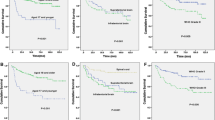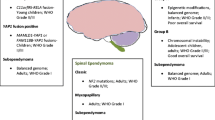Abstract
Intracranial ependymomas are the third most common primary brain tumor in children. A variety of chemotherapy protocols have been introduced for the treatment of ependymoma although overall these have not contributed to patients outcome. To our knowledge, data on the prognostic value of immunoexpression of the chemoresistance-related proteins (ChRPs) in ependymomas are absent. Seventy-six patients with intracranial ependymomas who received combined treatment were studied retrospectively. Tumor specimens were immunohistochemically examined with antibodies to metallothioneins (MT), glutathione S-transferase pi (GST pi) and P-glycoprotein (P-GP). The results demonstrated significant preponderance of expression of all the above-mentioned ChRPs for the low-grade tumors. The progression-free survival time was found to be significantly shorter for immunonegative tumors in both tumor grades. Multivariate analysis using a Cox hazard model revealed that recurrence-free survival time is significantly associated with tumor grade, and MT and P-GP expression. Risk of recurrence increased for the high-grade ependymomas (hazard ratio 2.85; P=0.004), and decreased for the MT-positive tumors (hazard ratio −2.72; P=0.005) and for the P-GP-positive tumors (hazard ratio −2.02; P=0.02). The obtained results allow one to conclude that ChRPs expression is closely associated with low-grade ependymomas and immunohistochemical findings may be estimated as a predictor for local tumor progression.
Similar content being viewed by others
References
Applegate GL, Marymont M: Intracranial ependymomas: a review. Cancer Invest 16: 588–593, 1998
Bouffet E, Perilongo G, Canete A, Massimino M: Intracranial ependymomas in children: a critical review of prognostic factors and a plea for cooperation. Med Pediatr Oncol 30: 319–329, 1998
Ernestus RI, Schr¨oder R, St¨utzer H, Klug N: The clinical and prognostic relevance of grading in intracranial ependymomas. Br J Neurosurg 11: 421–428, 1997
Foreman NK, Love S, Thorne R: Intracranial ependymomas: analysis of prognostic factors in a population-based series. Pediatr Neurosurg 24: l19–125, 1996
Gerszten PC, Pollack IF, Martínez AJ, Lo KH, Janosky J, Albright AL: Intracranial ependymomas of childhood. Lack of correlation of histopathology and clinical outcome. Pathol Res Pract 192: 515–522, 1996
Kovalic JJ, Flaris N, Grigsby PW, Pirkowski M, Simpson JR, Roth KA: Intracranial ependymoma long term outcome, patterns of failure. J Neurooncol 15: 125–131, 1993
McLaughlinMP, Marcus RBJ, Buatti JM, McColloughWM, Mickle JP, Kedar A, Maria BL, Million RR: Ependymoma: results, prognostic factors and treatment recommendations. Int J Radiat Oncol Biol Phys 40: 845–850, 1998
Nazar GB, Hoffman HJ, Becker LE, Jenkin D, Humphreys RP, Hendrick EB: Infratentorial ependymomas in childhood: prognostic factors and treatment. J Neurosurg 72: 408–417, 1990
Perilongo G, Massimino M, Sotti G, Canete A: Analyses of prognostic factors in a retrospective review of 92 children with ependymoma: Italian Pediatric Neurooncology Group. Med Pediatr Oncol 29: 79–85, 1997
Pollack IF, Gerszten PC, Martinez AJ, Lo KH, Shultz B, Albright AL, Janosky J, Deutsch M: Intracranial ependymomas of childhood: long-term outcome and prognostic factors. Neurosurgery 37: 655–666, 1995
Robertson PL, Zeltzer PM, Boyett JM, Rorke LB, Allen JC, Geyer R, Stanley Ph, Li H, Albright L, McGuire-Gullen P, Finlay JL, Stevens KR, Milstein JM, Packer RJ, Wisoff J and the Children's Cancer Group: Survival and prognostic factors following radiation therapy and chemotherapy for ependymomas in children: a report of the Children's Cancer Group. J Neurosurg 88: 695–703, 1998
Ross GW, Rubinstein LJ: Lack of histopathological correlation of malignant ependymomas with postoperative survival. J Neurosurg 70: 31–36, 1989
Schiffer D, Chio A, Cravioto H, Giordana MT, Migheli A, Soffietti R, Vigliani MC: Ependymoma: internal correlations among pathological signs: the anaplastic variant. Neurosurgery 29: 206–210, 1991
Schwartz TH, Kim S, Glick RS, Bagiella B, Balmaceda C, Fetell MR, Stein BM, Sisti MB, Bruce JN: Supratentorial ependymomas in adult patients. Neurosurgery 44: 721–731, 1999
Sutton LN, Goidwein J, Perilongo G: Prognostic factors in childhood ependymomas. Pediatr Neurosurg 16: 57–65, 1997
Evans AL, Anderson JR, Lefcowitz BL, Finlay JL: Adjuvant chemotherapy of childhood posterior fossa ependymoma: craniospinal irradiation with or without adjuvant CCNU, vincristin and prednisone: a Childrens Cancer Group study. Med Pediatr Oncol 27: 8–14,1996
Fouladi M, Baruchel S, Chan H, Grant R, Malkin D, Weitzman S, Greenberg ML: Use of adjuvant ICE chemotherapy in the treatment of anaplastic ependymomas. Childs Nerv Syst 14: 590–595, 1998
Grill J, Kalifa C: High dose chemotherapy for childhood ependymoma (letter). J Neuro-Oncol 40: 97, 1998
Kedar A: Chemotherapy for pediatric brain tumors. Semin Pediatr Neurol 4: 320–332, 1997
Needle MN, Goldwein JW, Grass J, Cnaan A, Bergman I, Molloy P, Sutton L, Zhao H, Garvin Jr JH, Phillips PC: Adjuvant chemotherapy for the treatment of intracranial ependymoma of childhood. Cancer 80: 341–347, 1997
Siffert J, Allen JC: Chemotherapy in recurrent ependymoma. Pediatr Neurosurg 28: 314–319, 1998
Souweidane MM, Bouffet E, Finlay J: The role of chemotherapy in newly diagnosed ependymoma in childhood. Pediatr Neurosurg 28: 273–278, 1998
Feun U, Savaraj N, Landy HJ: Drug resistance in brain tumors. J Neurooncol 20: 165–176, 1994
Lehnert M: Multidrug resistance of human cancer. J Neuro-Oncol 22: 239–243, 1994
Phillips PC: Antineoplastic drug resistance in brain tumors. Neurol Clin 9: 383–404, 1991
Hishikawa Y, Abe S, Kinugasa S, Yoshimura H, Monden N, Isarashi M, Tachibana M, Nagasue N: Overexpression of metallothionein correlates with chemoresistance to cisplatin and prognosis in esophageal cancer. Oncology 54: 342–347, 1997
Jasani B, Schmid KW: Significance of metallothionein overexpression in human tumours. Histopathology 31: 211–214, 1997
Monden N, Abe S, Hishikawa Y, Kinugasa S, Nagasue N: Prognostic significance of the expressions of metallothionein, glutathion S-transpherase pi and P-glycoprotein in curatively resected gastric cancer. Oncology 54: 391–399, 1997
Shmid KW, Ellis IO, Gee M, Darke BM, Lees WE, Kay J, Gryer A, Stark JM, Hittmer A, Ofner D: Presence and possible significance of immunocytochemically demonstrable metallothionein overexpression in primary invasive ductal carcinoma of the breast. Virchows Arch (A) Pathol Anat 422: 153–159, 1993
Siu LL, Banerjee D, Imurana RJ, PanX, Pflueger R, Tannock IF, Moore MJ: The prognostic role of p53, metallothionein, P-glycoprotein and MIB-1 in muscle invasive urothelial transitional cell carcinoma. Clin Cancer Res 4: 559–565, 1998
Uozaki H, Horiuchi H, Ishida T, Iijima T, Imamura T, Machinami R: Overexpression of resistance-related proteins (metallothioneins, glutathion S-transpherase pi, heat shock protein 27 and lung resistance-related protein) in osteosarcoma. Relationship with poor prognosis. Cancer 79: 2336–2349, 1997
Ali-Osman F, Bruner JM, Kultuk TM, Hess K: Prognostic significance of glutathione S-transferase pi expression and subcellular localization in human gliomas. Clin Cancer Res 3: 2253–2261, 1997
Bossanyi von P, Diete S, Dietzmann K, Warich Kirches M, Kirches E: Immunohistochemical expression of Pglycoprotein and glutathione S-transferases in cerebral gliomas and response to chemotherapy. Acta Neuropathol (Berl) 94: 605–611, 1997
Korshunov A, Golanov A, Sycheva R, Pronin I, Fadeeva L: Prognostic value of the immunoexpression of chemoresistance-related proteins in cerebral glioblastomas. Neuropathology 19: 143–149, 1999
Chou PM, Barquin N, Gonzales Crussi F, Ridaura Sanz C, Tomita T, Reyes Mugica M: Ependymomas in children express the multidrug resistance gene: immunohistochemical and molecular biology study. Pediatr Pathol Lab Med 16: 551–561, 1996
Geddes JF, Vowle GH, Ashmore SM, Cockburn HA, Darling JL: Detection of multidrug resistance gene product (Pglycoprotein) expression in ependymomas. Neuropathol Appl Neurobiol 20: 118–121,1994
Aschner M: The functional significance of brain metallothioneins. FASEB J 10: 1129–1136, 1996
Aschner M: Astrocyte metallothioneins (Mts) and their neuroprotective role. Ann NY Acad Sci 825: 334–347, 1997
Maier H, Jones C, Jasani B, Otner D, Zelger B, Schmid KW, Budka H: Methallothionein overexpression in human brain tumors. Acta Neuropathol (Berl) 94: 599–604, 1997
Sevlever G, Sinay V, Schultz M, Taratuto AL: Chemoresistance markers in the CNS tumors: their relationship with histological grading and proliferative activity (Abstract). Neuropathol Appl Neurobiol 22(suppl 1): 60, 1996
Kantor RR, Glardina SL, Bartolazzi A, Townsend AJ, Myers CE, Cowan KH, Longo DL, Natali PG: Monoclonal antibodies to glutathione S-transferase pi-immunohistochemical analysis of human tissues and cancers. Int J Cancer 47:193–201, 1991
Beiswanger CM, Diegmann MH, Novak RF, Philbert MA, Garessle TL, Reuhl KR, Lowndes HE: Developmental changes in the cellular distribution of glutathione and glutathione S-transferases in murine nervous system. Neurotoxicology 16: 425–440, 1995
Philbert MA, Bieswanger CM, Manson MM, Green JA, NovakRF, PrimianoT, Reuhl KR, Lowndes HE: Glutathione S-transferases and gamma-glutamyl transpeptidase in the rat nervous system: a basis for differential susceptibility to neurotoxicants. Neurotoxicology 16:339–342, 1995
Hara A, Yamada H, Sakai N, Hirayama H, Tanaka T, Mori H: Immunocytochemical demonstration of the palcental form of glutathione S-transferase, a detoxifying enzyme in human gliomas. Cancer 66: 2563–2568, 1990
Grant R, Ironside JW: Glutathione S-transferases and cytochrome P450 detoxifying enzyme distribution in human cerebral glioma. J Neuro-Oncol 25:1–7, 1995
Huai Yun H, Secrest DT, Mark KS, Carney D, Brandquist C, Elmquist WF, Miller DW: Expression of multidrug resistance-associated proteins (MRP) in brain microvessel endothelial cells. Biochem Biophys Res Commun 243: 816–820, 1998
Becker I, Becker KF, Meyerman R, Hillt V: Multidrugresistance gene MDR 1 is expressed in human glial tumors. Acta Neuropathol (Berl) 82: 516–519, 1991
Billson AL, Palmer JV, Walker DA, Lowe J: Multidrugresistance gene (MDR 1) expression in neuro-axial tumours 227 of children and young adults. Br J Neurosurg 8: 585–591, 1994
Dietzmann K, von Bossanyi P, Franke DS: Expression of P-glycoprotein as a multidrug resistance gene product in human reactive astrocytes and astrocytoma (in German). Zentralbl Pathol 140: 149–153, 1994
Henson JW, Cordon-Cardo C, Posner JB: P-glycoprotein expression in brain tumors. J Neurooncol 14: 37–43, 1992
Nabors MW, Griffin CA, Zehnbauer BA, Hruban RH, Phillips PC, Grossman SA, Brem H, Colvin OM: Multidrug resistance gene (MDR 1) expression in human brain tumors. J Neurosurg 75: 941–946, 1991
Kelley SL, Basu A, Teicher BA, Hacker MP, Hamer DH, Lazo JS: Overexpression of the methallothionein confers resistance to anticancer drugs. Science 241: 1813–1815, 1988
Doz F, Roosen N, Rosenblum ML: Metallothionein and anticancer agents: the role of metallothionein in cancer chemotherapy. J Neuro-Oncol 17: 123–129, 1993
Charles SM, Kenneth HC: Glutathione S-transferases and drug resistance. Cancer Cells 2: 15–22, 1990
Kartner N, Riordan JR, Ling V: Cell surface P-glycoprotein associated with multidrug resistance in mammalian cell lines. Science 221: 1285–1288, 1983
Author information
Authors and Affiliations
Rights and permissions
About this article
Cite this article
Korshunov, A., Sycheva, R., Timirgaz, V. et al. Prognostic Value of Immunoexpression of the Chemoresistance-related Proteins in Ependymomas: an Analysis of 76 Cases. J Neurooncol 45, 219–227 (1999). https://doi.org/10.1023/A:1006369829576
Issue Date:
DOI: https://doi.org/10.1023/A:1006369829576




